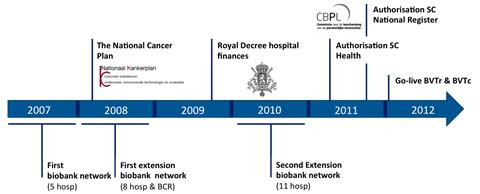History
In 2007, under the auspices of the Belgian foundation against cancer, a first biobank network was created gathering together oncologists and pathologists from five university hospitals (i.e. UZ Leuven, UZ Gent, Cliniques universitaires Saint-Luc, Hôpital Erasme, Institut Jules Bordet).
This first consortium evaluated the biobanking situation in the participating institutions, adopted the model of a virtual biobank, to be managed by the Belgian Cancer Registry, and set objectives in order to extend this Biobank project in 2008 to all the major Belgian university hospitals (UZ Antwerpen, UZ Brussel and CHU de Liège were added to the five previously mentioned institutions).
In March 2008 initiative 27 of the national cancer plan was launched and the subsequent rocal decree of September 20th 2009 indicated the conditions for hospitals to be financed in this initiative. This lead to an extension of the network to eleven biobanks in the course of 2010 (Institut de Pathologie et de Génétique Gosselies, CHU Brugmann and CHU de Mont-Godinne were added to the eight previously mentioned institutions).
In April 2011 the conceptual design of the initiative and the use of medical data for this objective was authorized by the commission for the protection of privacy, Sector Committee of Health. In October 2011 the Sector Committee of the National Register authorized the use of the national register number.
In the beginning of 2012 the web applications BVTr and BVTc (Belgian virtual tumourbank registration and catalogue module) went live for all authorized hospitals.

Timeline indicating the milestones of the Belgian virtual tumourbank initiative. Click to enlarge.
Top